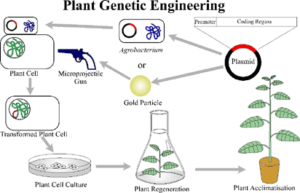Question
Rice has been modified by adding genes from bacteria and another plant so that it can produce the nutrient beta carotene.
What is this process called?
evolution
genetic engineering
mutation
selective breeding
▶️Answer/Explanation
B
The correct answer is: genetic engineering
Genetic engineering involves the manipulation of an organism’s genes using techniques like gene insertion, deletion, or modification. In this case, adding genes from bacteria and another plant to rice to enable it to produce beta carotene is a form of genetic engineering. This process allows scientists to introduce specific traits into an organism without relying on traditional methods like evolution or selective breeding.

Question
Corn is a crop plant. Glow-worms are organisms which give off light.
Which process could use these two species to make corn plants which glow?
A breeding the organisms together
B causing mutations in the organisms
C selective breeding
D transferring genes from one species to another species
▶️Answer/Explanation
D
The process that could use these two species to make corn plants that glow is “D – transferring genes from one species to another species.”
This process involves genetic engineering, where specific genes responsible for the bioluminescent trait in glow-worms could be isolated and inserted into the genome of corn plants. This would result in corn plants that have the ability to produce light, similar to how glow-worms do. This kind of genetic manipulation is commonly used in biotechnology to introduce desirable traits from one species into another, and it’s often referred to as genetically modified organisms (GMOs) or genetic engineering.
Question
What is inserted into a bacterium to make the bacterium produce insulin?
A a length of DNA from a human
B a length of DNA from another bacterium
C a molecule of insulin
D an enzyme
▶️Answer/Explanation
Correct Answer: A
In order to make a bacterium produce insulin, a length of DNA from a human (option A) containing the gene that codes for insulin production is inserted into the bacterium. This process involves genetic engineering techniques where the human gene responsible for producing insulin is inserted into the bacterium’s genome. The bacterium then uses the instructions from the inserted human DNA to produce insulin, which can be harvested and used for medical purposes. This technique is commonly used to produce therapeutic proteins like insulin in large quantities.
Question
Which statement about genetic engineering is correct?
A It involves choosing which individual organisms are used for breeding.
B It is always done using genes from the same species.
C It produces a new combination of genes.
D It produces exact copies of individual organisms.
▶️Answer/Explanation
C. It produces a new combination of genes.
Genetic engineering involves manipulating an organism’s genes using various techniques, such as recombinant DNA technology. This can include inserting genes from different species (transgenic) or modifying an organism’s existing genes. The goal is to create organisms with specific desired traits or to produce certain substances. As a result of these manipulations, genetic engineering often leads to the creation of organisms with new combinations of genes that may not occur naturally.
Question
Which is a reason for using bacteria in biotechnology?
A Bacteria are found inside the human body.
B Bacteria can become resistant to antibiotics.
C Bacteria can make complex molecules.
D Bacteria reproduce slowly.
▶️Answer/Explanation
Correct Answer: C Bacteria can make complex molecules.
Explanation: One of the key reasons for using bacteria in biotechnology is their ability to produce a wide range of complex molecules through processes such as fermentation and recombinant DNA technology. Bacteria can be engineered to produce various useful substances, including enzymes, proteins, antibiotics, biofuels, and pharmaceuticals. This capacity for molecular production makes bacteria valuable tools in biotechnological applications. While the other options (A, B, and D) might have some relevance in certain contexts, they are not the primary reasons for using bacteria in biotechnology.
